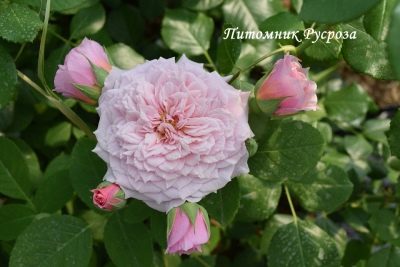
- Authors: Massad
- Name synonyms: William Christie, MASwicri, William Christie
- Breeding year: 1994
- Group: scrub, bush
- The main color of the flower: pink
- Flower shape: rosette
- Flower size: medium
- Diameter, cm: 6-8
- Flower type by number of petals: thick double
- Scent: citrus with notes of passionfruit and myrrh
Rose William Christie was created in France in 1994. She also has the names William Christie, MASwicri, William Christie. The variety belongs to the group of scrub, bush. It is perfect for the formation of single and group decorative plantings.
Description of the variety
William Christie is a vigorous shrub with erect shoots. The height of a healthy adult plant reaches 110-150 cm on average, and its average width is 100 cm.
Leaves on shrubs of rich green colors. Their size is average. The flowers have a beautiful pale pink color, the central part of them, as a rule, is painted in soft apricot.
All flowers are rosette-shaped, their sizes are medium. The diameter of each of them is 6-8 centimeters. This rose is double double. Blooming flowers can be located on the stem singly or collected in separate inflorescences. They keep their shape well and do not bloom.
The plant has a pleasant citrus aroma with hints of myrrh and passion fruit. The intensity of the aroma is medium.
Advantages and disadvantages
Rose William Christie boasts an unusual and beautiful appearance. Lush flowers of the original shape allow you to create interesting decorative compositions. And also among the advantages of the variety, it is worth noting a very high resistance to frost (withstands temperatures from -23 to -29 degrees Celsius), high resistance to various fungal diseases.
Flowering features
The flowering period is quite long, it starts in June and ends with the onset of the first frost. At the same time, flowering is quite abundant. Rose William Christie is re-flowering.
In the process of flowering on the bushes, buds of a pale pink color are first formed. Their shape is round and slightly elongated. Gradually, full-fledged volumetric flowers are formed from them.
Landing
It is better to plant seedlings at a distance of 0.5 meters from each other. Landing pits are prepared in advance. Their depth should be a couple of centimeters deeper compared to the length of the roots of the vegetation.
Planting times will vary by region. So, in the southern territories, planting is quite possible in the fall. In mid-latitudes, disembarkation can be performed both in autumn and spring.
Growing and care
This rose requires regular watering. In this case, one shrub should take 15-20 liters of water. This procedure is performed twice a week if the weather is warm and dry. And also the flower needs feeding. It is best to apply fertilizers with nitrogen in spring, and with potassium and phosphorus in summer.
William Christie also requires pruning. In the first year after planting in open ground, it is necessary to remove early buds; at the end of summer, only 1-2 flowers should be left on each shoot.
Despite the fact that this species is very frost-resistant, shrubs must be covered at temperatures below -23 degrees Celsius. It is better to pre-mulch the land around it.
Diseases and pests
William Christie boasts a special resistance to diseases and harmful insects. But still, sometimes a rose can be affected by fungal diseases, including powdery mildew, black spot. In this case, damage first appears on the leaf blades, and then spreads throughout the plant.To restore decorative plantings, various fungicides are used.
And also sometimes on plants you can see aphids, spider mites, roseworm, thrips. If there are few of them, then it is better to first remove them manually, and then carry out the treatment with insecticides.
Review overview
According to gardeners, the William Christie rose has a beautiful appearance, flowers of an unusual shape. At the same time, compact shrubs look as neat as possible. And also gardeners noticed that such a variety blooms profusely without interruption. Blooming flowers practically do not fade under the influence of sunlight, they easily tolerate rain and winter.































































